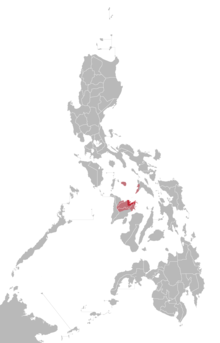Capiznon language
| Capiznon | |
|---|---|
| Capiceño | |
| Binisaya, Binisaya nga Capiznon, Bisaya | |
| Native to | Philippines |
| Region | Capiz and some portions of Iloilo, Aklan, and Masbate |
| Ethnicity | Capiznon |
Native speakers | 640,000 (2000)[1] |
Language family | Austronesian
|
| Language codes | |
| ISO 639-3 | cps |
| Glottolog | capi1239 |
 Area where Capiznon is spoken | |
Capiznon/Kapisnon (Capiceño) or Bisaya nga Kinapisnon [2][3][4] is an Austronesian regional language spoken in Western Visayas in the Philippines. Capiznon is concentrated in the province of Capiz in the northeast of Panay Island. It is a member of the Bisayan language family and the people are part of the wider Visayan ethnolinguistic group, who constitute the largest Filipino ethnolinguistic group. The language is often confused with Hiligaynon due to dialectological comprehension similarities and as high as 91% mutual intelligibility,[5] but it has its certain unique accent and vocabulary that integrates Aklanon and Waray lexicon.[6] Despite its distinct corruption of Hiligaynon lateral approximants, a prevalent feature among rural farmers, ethnic convergence and cosmopolitanism has led to a shift back to the purely Hiligaynon prosodic form of slower tonality and softer and longer vowels most particularly among the younger generations.
Distribution[]
Capiznon is spoken in the following municipalities:
- Capiz
- Roxas City
- Ivisan
- Panay
- Panitan
- Maayon
- Dao
- Pilar
- Mambusao
- Pontevedra
- President Roxas
- Sapi-an
- Sigma
- Cuartero
- Dumarao
- Dumalag
- Jamindan
- Tapaz
- Iloilo
- Batad
- Calinog
- Bingawan
- Lemery
- Passi City
- Lambunao
- Carles
- Estancia
- Sara
- San Rafael
- Concepcion
- San Dionisio
- Balasan
- San Enrique
- Ajuy
- Dueñas
- Aklan
- Altavas
- Batan
- Balete
- Libacao
- Banga
- Kalibo
- New Washington
- Masbate
- Balud
- Mandaon
- Romblon
- Cajidiocan
- Magdiwang
- San Fernando
Common lexical differences between Capiznon and Hiligaynon languages[]
| Capiznon | Hiligaynon | English |
|---|---|---|
| yanda | subong | today/now |
| ini/mini/muni | ini/amo ini/amo ni | this |
| ina/mina/muna | ina/amo ina | that/these is ours |
| patawa | kadlaw | laugh |
| palataw-an | kaladlawan | funny |
| idot | iyot | sex |
| malukong | yahong | bowl |
| ti-aw/dinaskal | lango-lango | joke |
| palanggana | labador | washbasin |
| pawa | sanag | bright/luminous |
| wakal/hala/hambal | hambal | talk |
| lagbong/hulog | hulog | fall |
| puya | bata | child |
| pilaw | tuyo | sleepy |
| tamarindo | sambag | tamarind tree |
| tangis | hibi | cry |
| laong | pahanugot/lisensya | consent |
| samad | guba | to break/broken |
| siki | tiil | foot |
| mayad | maayo | fine/good |
| gutos | lakat/baktas | to travel by foot |
| gumangkon | hinablos | nephew/niece |
| libod | lagaw | to stroll around |
| hamyang | haya | wake |
| umog | lagu | used and unwashed clothes |
| hinipo | agot | youngest child |
| talisik / panalisik | taliti / panaliti | drizzle / drizzling |
| pinsan | tingub | together |
| sanduko | binangon | bolo |
| dalunggan | talinga | ears |
| kuracha | tanga | cockroach |
| sudlay | husay | comb |
| pinaisan | pinamalhan | marinated fish |
| bundol | mango | dumb |
| lupos | subak | ingredient |
| dayok | ginamos | shrimp paste |
| sim | sim | tin roof |
| hay! | te! | see! |
| sili | katumbal | chilli pepper |
| paukoy / pahimuyong | pahimunong | quiet |
| latoy | balatong | string beans |
| daha | tig-ang | to cook rice |
| lurop | sirop | to dive underwater |
| luyo | tupad /ingod | adjacent |
| kuracha | tanga | cockroach |
| dulog | hulid | to sleep together |
| uyapad | uma | ricefield |
| migo/miga | uyab | boyfriend/girlfriend |
| mayad | maayo | good |
| mayad | pali | healed /cured |
| unlan | ulunan /ulonan | pillow |
| habukon | palak-palak /tikalon | boastful / arrogant |
See also[]
- Hiligaynon language
- Capiz
- Capiznon people
External links[]
| Wikivoyage has a travel guide for Capiznon phrasebook. |
References[]
- ^ Capiznon at Ethnologue (18th ed., 2015)
- ^ gov.ph[dead link]
- ^ "Explore Philippines >> Capiz >> Things to Do". Wow Philippines. Archived from the original on 2009-04-14. Retrieved 2009-03-07.
- ^ "Profile of the Province". Poverty Mapping – Masbate. National Statistical Coordination Board. Archived from the original on 2009-04-24. Retrieved 2009-03-07.
- ^ "Capiznon". Ethnologue.
- ^ "The Capiznon Language". capiz.gov.ph.
| Capiznon language test of Wikipedia at Wikimedia Incubator |
- Visayan languages
- Languages of Capiz
- Languages of Iloilo
- Languages of Aklan
- Languages of Masbate